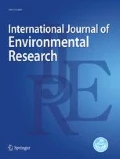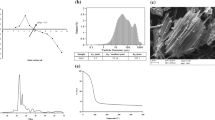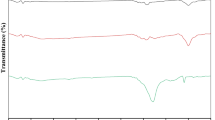Abstract
This study demonstrates the sorptive removal of reactive orange 16 (RO-16), a textile dye from water, as well as, from a local textile industry via activated alumina-based batch technique. The adsorption of the dye was pH-dependent within the range of 2.49–12.21. Thermodynamic parameters such as ∆Ho, ∆So and ∆Go were obtained from Van’t Hoff equation applied to the obtained data at temperature 303, 323, 333, and 343 K. Further, the adsorption data were applied to the well-known Langmuir isotherm model, and the competitive sorption of RO-16 was studied in the presence of other commonly used reactive dyes (used in textile dyeing process), namely: Remazol brilliant blue R, reactive black 5, and reactive red 120. Effect of various chemicals used in the textile dyeing process such as acetic acid, formic acid, urea, sodium chloride, sodium nitrate, sodium sulfate, sodium phosphate, and sodium carbonate on the adsorption of RO-16 was studied in the concentration range of 500–5000 mg.L−1. Briefly, RO-16 removal was not affected by the urea, and formic acid addition; however, 3000 mg.L−1 of acetic acid showed up to 30% decrease in RO-16 removal. Chloride and nitrate did not affect RO-16 removal; nevertheless, carbonate, sulfate, and phosphate prominently decreased the adsorption efficiency at > 1000 mg.L−1 concentration. Increase in temperature from 303 to 353 K, and therefore the negative ΔSo observed during all batches, manifests that the proposed adsorption process is exothermic. The optimized adsorption conditions represented 98.54% RO-16 removal upon mixing with real wastewater from a local textile industry.
Research Highlights
-
Sorptive removal of reactive orange 16.
-
Activated alumina for selective removal of reactive orange 16.
-
Effect of various chemicals on the proposed adsorption study.
-
Application of the designed study to textile wastewater.








Similar content being viewed by others
Data Availability
Data generated during the study are subject to a data sharing mandate and available in a public repository, however, does not issue datasets with DOIs.
References
Al-Degs YS, El-Barghouthi MI, El-Sheikh AH, Walker GM (2008) Effect of solution pH, ionic strength, and temperature on adsorption behavior of reactive dyes on activated carbon. Dyes Pigm 77(1):16–23. https://doi.org/10.1016/j.dyepig.2007.03.001
Ali I, Konkova T, Belkina I, Galunin E, Rysev A, Morozov A et al (2021) Facile synthesis and characterization of advanced cobalt materials for degradative and adsorptive removal of carmoisine in water. Int J Environ Sci Technol 18(10):3221–3236. https://doi.org/10.1007/s13762-021-03529-2
Anjaneyulu Y, Sreedhara Chary N, Suman Raj DS (2005) Decolourization of industrial effluents–available methods and emerging technologies–a review. Rev Environ Sci Bio/technol 4(4):245–273. https://doi.org/10.1007/s11157-005-1246-z
Bajracharya A, Liu Y-L, Lenhart JJ (2019) The influence of natural organic matter on the adsorption of microcystin-LR by powdered activated carbon. Environ Sci: Water Res Technol 5(2):256–267. https://doi.org/10.1039/C8EW00582F
Cestari AR, Vieira EF, Dos Santos AG, Mota JA, De Almeida VP (2004) Adsorption of anionic dyes on chitosan beads. 1. The influence of the chemical structures of dyes and temperature on the adsorption kinetics. J Colloid Interface Sci 280(2):380–386. https://doi.org/10.1016/j.jcis.2004.08.007
Ding Y, Wang Y, Su L, Bellagamba M, Zhang H, Lei Y (2010) Electrospun Co3O4 nanofibers for sensitive and selective glucose detection. Biosens Bioelectron 26(2):542–548. https://doi.org/10.1016/j.bios.2010.07.050
Domingues G, Düsman E, Vicentini VEP (2020) Cytotoxicity of crude and treated liquid effluents from textile industry dyeing using bioindicator Allium cepa L. Water Air Soil Pollut 231(9):448. https://doi.org/10.1007/s11270-020-04818-1
Ekici S, Işıkver Y, Şahiner N, Saraydın D (2003) Adsorption of some textile dyes onto crosslinked poly (N-vinylpyrrolidone). Adsorpt Sci Technol 21(7):651–659. https://doi.org/10.1260/026361703772776439
Ewis D, Ba-Abbad MM, Benamor A, Mahmud N, Nasser M, El-Naas M, Mohammad AW (2022) Adsorption of 4-nitrophenol onto iron oxide bentonite nanocomposite: process optimization, kinetics, isotherms and mechanism. Int J Environ Res 16(2):1–13. https://doi.org/10.1007/s41742-022-00402-z
Feng W, Guo Z, Peng C, Xiao X, Shi L, Han X, Ran H (2018) Modelling mass balance of cadmium in paddy soils under long term control scenarios. Environ Sci Process Impacts 20(8):1158–1166. https://doi.org/10.1039/C8EM00153G
Feng L, Liang F, Xu L, Ji L, He Q, Yan S (2021) Simultaneous biogas upgrading, CO2 sequestration, and biogas slurry decrement using biomass ash. Waste Manage 133:1–9. https://doi.org/10.1016/j.wasman.2021.07.029
Gullo M, Verzelloni E, Canonico M (2014) Aerobic submerged fermentation by acetic acid bacteria for vinegar production: process and biotechnological aspects. Process Biochem 49(10):1571–1579. https://doi.org/10.1016/j.procbio.2014.07.003
Ince N, Gönenç D (1997) Treatability of a textile azo dye by UV/H2O2. Environ Technol 18(2):179–185. https://doi.org/10.1080/09593330.1997.9618484
Jibril M, Noraini J, Poh LS, Evuti AM (2013) Removal of colour from waste water using coconut shell activated carbon (CSAC) and commercial activated carbon (CAC). Jurnal Teknologi. https://doi.org/10.11113/jt.v60.1435
Jie W, Zhenyu L, Xin H, Tao Y, Mengliang L, Qiubai D et al (2021) Porous materials prepared by magnesium phosphate cement for the effective immobilization of lead ions. Int J Environ Res 15(4):681–694. https://doi.org/10.1007/s41742-021-00344-y
Khare SK, Panday KK, Srivastava RM, Singh VN (1987) Removal of victoria blue from aqueous solution by fly ash. J Chem Technol Biotechnol 38(2):99–104. https://doi.org/10.1002/jctb.280380206
Khayyun TS, Mseer AH (2019) Comparison of the experimental results with the Langmuir and Freundlich models for copper removal on limestone adsorbent. Appl Water Sci 9(8):1–8. https://doi.org/10.1007/s13201-019-1061-2
Kumar R, Sharma P, Aman AK, Singh RK (2020) Equilibrium sorption of fluoride on the activated alumina in aqueous solution. Desalination Water Treat 197:224–236. https://doi.org/10.5004/dwt.2020.26002
Lee J-W, Choi S-P, Thiruvenkatachari R, Shim W-G, Moon H (2006a) Evaluation of the performance of adsorption and coagulation processes for the maximum removal of reactive dyes. Dyes Pigm 69(3):196–203. https://doi.org/10.1016/j.dyepig.2005.03.008
Lee J-W, Choi S-P, Thiruvenkatachari R, Shim W-G, Moon H (2006b) Submerged microfiltration membrane coupled with alum coagulation/powdered activated carbon adsorption for complete decolorization of reactive dyes. Water Res 40(3):435–444. https://doi.org/10.1016/j.watres.2005.11.034
Lin SH, Lin CM (1993) Treatment of textile waste effluents by ozonation and chemical coagulation. Water Res 27(12):1743–1748. https://doi.org/10.1016/0043-1354(93)90112-U
Low B-T, Ting Y-P, Deng S (2008) Surface modification of Penicillium chrysogenum mycelium for enhanced anionic dye removal. Chem Eng J 141(1–3):9–17. https://doi.org/10.1016/j.cej.2007.10.004
Malachová K, Pavlícková Z, Novotný C, Svobodová K, Lednická D, Musílková E (2006) Reduction in the mutagenicity of synthetic dyes by successive treatment with activated sludge and the ligninolytic fungus, Irpex Lacteus. Environ Mol Mutagen 47(7):533–540. https://doi.org/10.1002/em.20224
Meher AK, Jadhav A, Labhsetwar N, Bansiwal A (2020) Simultaneous removal of selenite and selenate from drinking water using mesoporous activated alumina. Appl Water Sci 10(1):1–12. https://doi.org/10.1007/s13201-019-1090-x
Mohammad NK, Ghaemi A, Tahvildari K (2019) Hydroxide modified activated alumina as an adsorbent for CO2 adsorption: experimental and modeling. Int J Greenhouse Gas Control 88:24–37. https://doi.org/10.1016/j.ijggc.2019.05.029
Mthembu PP, Elumalai V, Senthilkumar M, Wu J (2021) Investigation of geochemical characterization and groundwater quality with special emphasis on health risk assessment in alluvial aquifers, South Africa. Int J Environ Sci Technol 18(12):3711–3730. https://doi.org/10.1007/s13762-021-03129-0
Needles HL (1986) Textile fibers, dyes, finishes, and processes: a concise guide
Omahony T, Guibal E, Tobin J (2002) Reactive dye biosorption by Rhizopus arrhizus biomass. Enzyme Microbial Technol 31(4):456–463. https://doi.org/10.1016/S0141-0229(02)00110-2
Panhwar A, Faryal K, Kandhro A, Qaisar S (2019) Assessment of textile industrial effluent by wastewater quality standards. Econ Survey 2017:18
Philips D (1996) Environmentally friendly, productive and reliable: priorities for cotton dyes and dyeing processes. J Soc Dyers Colour 112(7–8):183–186. https://doi.org/10.1111/j.1478-4408.1996.tb01814.x
Potgieter JH, Potgieter-Vermaak SS, Modise J, Basson N (2005) Removal of iron and manganese from water with a high organic carbon loading. Part II: the effect of various adsorbents and nanofiltration membranes. Water Air Soil Pollut 162(1):61–70. https://doi.org/10.1007/s11270-005-5993-9
Ravi S, Shoparwe N, Abdul-Halim N, Makhtar M, Shukor H (2021) Fabrication and characterisation of polyvinylidene fluoride co-hexafluoropropylene polymer inclusion membranes for reactive orange 16 dye removal. Paper presented at the IOP Conference Series: Earth and Environmental Science. https://doi.org/10.1088/1755-1315/765/1/012103
Rayane S, Chaza C, Sopheak N, Moomen B, Baghdad O (2021) Application of continuous column adsorption of organochlorine pesticides from contaminated water onto date stones activated carbon. Int J Environ Res 15(4):585–595. https://doi.org/10.1007/s41742-021-00337-x
Robinson T, McMullan G, Marchant R, Nigam P (2001) Remediation of dyes in textile effluent: a critical review on current treatment technologies with a proposed alternative. Biores Technol 77(3):247–255. https://doi.org/10.1016/S0960-8524(00)00080-8
Rocha BN, Bellato FC, Arantes CC, de Jesus TA (2022) Four-month assessment of water quality in a channeled urban stream in São Paulo State, Brazil. Water Air Soil Pollut 233(3):73. https://doi.org/10.1007/s11270-022-05553-5
Rodrigo M, Dos Santos E (2021) Electrochemically assisted remediation of contaminated soils. Springer
Rosa S, Laranjeira MC, Riela HG, Fávere VT (2008) Cross-linked quaternary chitosan as an adsorbent for the removal of the reactive dye from aqueous solutions. J Hazard Mater 155(1–2):253–260. https://doi.org/10.1016/j.jhazmat.2007.11.059
Sciban M, Klasnja M, Skrbic B (2006) Modified hardwood sawdust as adsorbent of heavy metal ions from water. Wood Sci Technol 40(3):217. https://doi.org/10.1007/s00226-005-0061-6
Sharma P, Kaur H, Sharma M, Sahore V (2011) A review on applicability of naturally available adsorbents for the removal of hazardous dyes from aqueous waste. Environ Monit Assess 183(1):151–195. https://doi.org/10.1007/s10661-011-1914-0
Sheehan D (2018) A symmetric Van’t Hoff equation and equilibrium temperature gradients. J Non-Equilib Thermodyn 43(4):301–315. https://doi.org/10.1515/jnet-2017-0007
Song F-M, Ge H-G, Shi J, Liu Z-F, Li C, Tang B (2021) Retraction note: adsorption kinetics and thermodynamics of Ni (II) by Pisha sandstone. J Nanopart Res 23(8):169. https://doi.org/10.1007/s11051-020-04894-8
Tan BH, Teng TT, Omar AM (2000) Removal of dyes and industrial dye wastes by magnesium chloride. Water Res 34(2):597–601. https://doi.org/10.1016/S0043-1354(99)00151-7
Tsamo C, Djomou Djonga PN, Dangwang Dikdim JM, Kamga R (2018) Kinetic and equilibrium studies of Cr(VI), Cu(II) and Pb(II) removal from aqueous solution using red mud, a low-cost adsorbent. Arab J Sci Eng 43(5):2353–2368. https://doi.org/10.1007/s13369-017-2787-5
Tseng CH, Chang SM, Hu SC, Chen YC, Shiue A, Li Z et al (2021) Platinum-supported aluminum oxide on activated carbon filter media for removal of formaldehyde in the indoor condition. Int J Environ Sci Technol 18(12):3747–3760. https://doi.org/10.1007/s13762-021-03130-7
Tsui LS, Roy WR, Cole MA (2003) Removal of dissolved textile dyes from wastewater by a compost sorbent. Color Technol 119(1):14–18. https://doi.org/10.1111/j.1478-4408.2003.tb00145.x
Vijayaraghavan K, Yun Y-S (2008) Competition of Reactive red 4, Reactive orange 16 and Basic blue 3 during biosorption of Reactive blue 4 by polysulfone-immobilized Corynebacterium glutamicum. J Hazard Mater 153(1–2):478–486. https://doi.org/10.1016/j.jhazmat.2007.08.079
Vijayaraghavan K, Won SW, Yun Y-S (2008) Single-and dual-component biosorption of reactive black 5 and reactive orange 16 onto polysulfone-immobilized esterified Corynebacterium glutamicum. Ind Eng Chem Res 47(9):3179–3185. https://doi.org/10.1021/ie071537p
Walker G, Weatherley L (1997) Adsorption of acid dyes on to granular activated carbon in fixed beds. Water Res 31(8):2093–2101. https://doi.org/10.1016/S0043-1354(97)00039-0
Wang X, Li J, Zhang X, Chen Z, Shen J, Kang J (2021) Effect of aerobic granular sludge concentrations on adsorption and biodegradation to oxytetracycline. Water Air Soil Pollut 232(5):184. https://doi.org/10.1007/s11270-021-05140-0
Wang LK, Vaccari DA, Li Y, Shammas NK (2005) Chemical precipitation. Physicochemical treatment processes (pp. 141–197): Springer. https://doi.org/10.1385/159259820x
Won SW, Choi SB, Yun Y-S (2006) Performance and mechanism in binding of Reactive Orange 16 to various types of sludge. Biochem Eng J 28(2):208–214. https://doi.org/10.1016/j.bej.2005.11.006
Acknowledgements
The first author gratefully acknowledges the financial support of Higher Education Commission (HEC) of Pakistan to sponsor this research in South Korea.
Author information
Authors and Affiliations
Corresponding author
Ethics declarations
Conflict of Interest
The authors declare that they have no known competing financial interests or personal relationships that could have appeared to influence the work reported in this paper.
Rights and permissions
Springer Nature or its licensor holds exclusive rights to this article under a publishing agreement with the author(s) or other rightsholder(s); author self-archiving of the accepted manuscript version of this article is solely governed by the terms of such publishing agreement and applicable law.
About this article
Cite this article
Rauf, N., Tahir, S.S., Yoon-Seok, C. et al. Selective Removal of Reactive Orange 16 via Adsorption onto Activated Alumina, and Its Application to Textile Wastewater. Int J Environ Res 16, 95 (2022). https://doi.org/10.1007/s41742-022-00479-6
Received:
Revised:
Accepted:
Published:
DOI: https://doi.org/10.1007/s41742-022-00479-6




